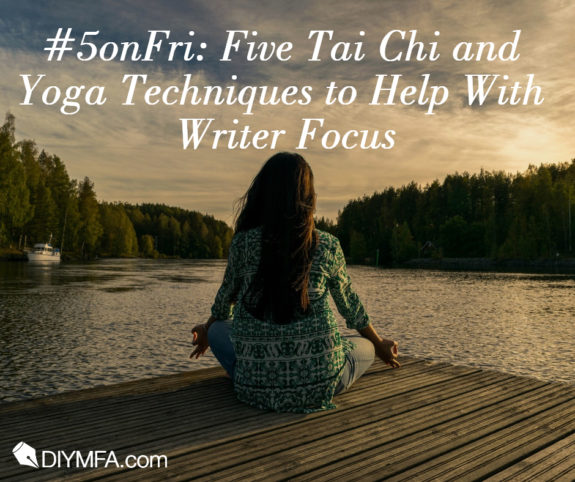I began practicing Korean Breath Qigong yoga to reduce stress. I would leave class feeling relaxed and brimming with creative energy. Inspired to share this with others, I am now a certified instructor. I am also an alumni of Pixels to Platform and DIY MFA 101. Thanks to the philosophy of Pixels to Platform, teaching Qigong is part of my author brand. In my daily writing I use techniques from my class to reduce mental and physical fatigue and to fuel creativity. I have found these five exercises to be the most helpful. No yoga mat needed!
1) Tapping
I start class with this warm up and use it when feeling fatigued from hours staring at a screen. When your thoughts are scattered so is your energy. Tapping gathers energy to your body, reduces mental stress and fatigue, opens up stagnant energy which registers as tension (headaches, neck strain, etc.), and relaxes your brain.
To begin a writing session, clap your hands a few times. Use the fingertips of your right hand to lightly tap your left arm. With your left palm facing down, tap in rhythm (about three taps per second) from your shoulder down to your hand, then back up to your shoulder. Repeat with your left thumb pointing up, then with your left palm facing down. Switch hands, using the fingertips of your left hand to tap your right arm. Finish by clapping a few times.
At the end of a writing session, use your fingertips to lightly tap your head, working up from the base of your neck to the top of your head, down the sides to your temples, and across your forehead. Finish by brushing your palms from the top of your head, across your shoulders, then down your shoulders three times, “sweeping” away tired energy.
2) Stretches
I use this five-minute stretching routine when tension creeps into my shoulders and my thought process slows down.
Bounce your shoulders for a few seconds. Rotate your shoulders backwards four times, then forwards four times.
With your arms extended to the side, rotate your wrists slowly four times in one direction, then in the opposite direction.
Stand with your feet together. Interlace your hands in front of your belly, palms facing up. Slowly breathe in and lift your palms to the ceiling, rotating your hands outward until they again face up above your head. Stay there a moment, pressing your hands up and your feet into the ground. Slowly breathe out as you lower your hands. Repeat two more times.
3) Breathing with hand movements
Whenever I get stuck in a writing project, I use this to synchronize mind and body. The pace of breathing and thinking are connected. When your thoughts ramp up it’s time for a breathing break. This breathing relaxes your nervous system and frees you from over thinking.
Sitting or standing, close your eyes. Focusing on your belly, breathe in slowly, expanding your belly, then breathe out slowly, relaxing your belly. Repeat for several breaths. Now lift your hands so they are at waist level, palms up. Breathe in slowly, lifting up your hands at the same pace as your breathing, up to shoulder level. Stay there a moment, then slowly lower your hands back to your waist as you breathe out. Repeat five times.
Lower your hands and bring them close together in front of your belly, facing your palms without touching. Breathe in slowly, pulling your hands apart to a comfortable distance. Stay there a moment, then slowly breathe out, bringing your hands close. Repeat five times.
I recommend listening to instrumental music during this exercise because it keeps your breathing at a slow pace, tracks time without looking at a clock, and transports you to another place.
4) Singing
My writing schedule includes singing breaks. When writing, your shoulder muscles tense up over time. Writing flows from your brain, down your shoulder, and out your fingertips. When those muscles tense up, that energy flow is disrupted and so is your creative process.
Singing expands your chest, opens your shoulders, increases oxygen circulation, and engages different parts of your brain.
Have fun with this! Try singing songs from the setting of your book.
5) Tree Posture
My favorite posture creates the proper energy balance of a cool head, warm hands and feet. With a cool head, your thinking is clear and focused. All energy is concentrated on the present moment which reduces “shiny object syndrome.”
It also increases circulation and releases tension from your back and legs when you have been sitting for too long.
This is best done standing, though you can sit in a chair. Stand with your feet shoulder width apart (if you are sitting, keep your feet flat on the floor). Bend your knees as you are able. Press your palms together in front of your heart, as in prayer. Relax your neck and shoulders, keeping your chin level. Close your eyes. Breathe in slowly, expanding your belly, then breathe out slowly, sending all energy to your legs, the trunk of your tree. Continue this process for two-three minutes, focusing only on your breathing in the present moment.
Take a break once during every hour of sitting, using one of these techniques. You will feel refreshed and refueled with creative energy!
 Ambre Dawn Leffler is an author, gardener, designer, lover of trees, and weather geek. She writes about vegetables, seasons, the interconnections of mind/body, and the environment. Learn more about her work in harmonious living at her website ambredawnleffler.com and on twitter @AmbreDLeffler.
Ambre Dawn Leffler is an author, gardener, designer, lover of trees, and weather geek. She writes about vegetables, seasons, the interconnections of mind/body, and the environment. Learn more about her work in harmonious living at her website ambredawnleffler.com and on twitter @AmbreDLeffler.







